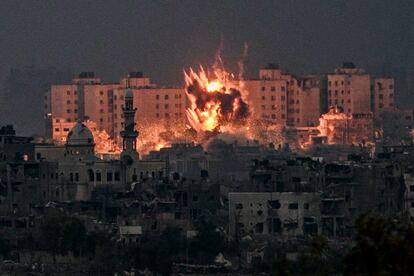Israel on verge of invasion of Gaza to ‘completely destroy’ Hamas
Tens of thousands of Palestinians have joined a mass exodus towards the south of the Strip amid bombings and scenes of chaos and desperation

Israel’s open secret in the wake of last Saturday’s offensive by Hamas — the launch of a full-scale ground invasion to wipe out the militant group’s authority in Gaza — appears now to be a matter of hours. “Are you ready for the next phase?” Israeli Prime Minister Benjamin Netanyahu asked troops stationed on the border with Gaza on Saturday afternoon. Israeli military spokesman Daniel Hagari solemnly spelled out the operation’s objective: “To completely destroy the government and military capacity of Hamas and the terrorist organizations.” That is to say, to overthrow the Islamist movement whose political wing has ruled Gaza since 2007, and whose armed wing carried out the most lethal single assault in history inside Israeli territory, with 1,400 dead — mainly civilians — and 126 kidnapped.
The Israeli Defense Force (IDF) is planning a “coordinated and integrated attack by land, sea and air,” the aim of which is to reach “the heart of Gaza,” from which tens of thousands of Palestinians have fled since Friday in the wake of the Israeli ultimatum. The army ordered 1.1 million people, nearly half of its inhabitants (including those in Gaza City, the capital) to head south. “Get out of Gaza City. We are watching you. For your own safety and the safety of your families. We are attacking Gaza City because it is the center of Hamas’ government and military capabilities,” Hagari told those who remained on Saturday.
Meanwhile, Israel is continuing its massive bombardment of Gaza, which has caused some 2,300 deaths, at least 734 of them minors, according to data from the Ministry of Health of the Gaza Strip. Nearly half a million people have been displaced and some 1,300 buildings destroyed, according to the United Nations, which warns that not even their shelters “are safe anymore.”
Some 35,000 people are seeking protection, crammed into the Al Shifa facility, Gaza’s main hospital. It is in the area Israel ordered civilians to evacuate. Its director, Mohamed Abu Selim, has claimed that a multitude of refugees are crowded into the building and its outer courtyard. “People think this is the only safe space after their homes were destroyed and they were forced to flee,” said a Gaza Health Ministry official.
With all border crossings closed, the Strip is holding its breath. The Israeli ultimatum also affects foreigners residing in Gaza, who are trying to leave through the Rafah border crossing to reach Egypt, through the efforts of foreign ministries. Cairo has made it clear that it will not accept a massive influx of refugees.
Hamas has tried to prevent the exodus through messages issued from mosques. It sees Israel’s ultimatum as an “extraordinarily audacious and brutal mission to forcibly remove Palestinians from their land.” But tens of thousands of people (hundreds of thousands, according to the Israeli army) have left their homes heading south, along two parallel roads along the 42 kilometers (26 miles) that separate the southern and northern tips of Gaza. Israel has guaranteed safe passage along the corridor, although the Hamas government claims that Israeli shelling killed 70 people along the route. UN Secretary-General António Guterres has described such a massive population movement as “extremely dangerous and, in some cases, simply impossible.”
A “new phase”
Israel has made clear its intention to move imminently to a “new phase” in the operation, at such time as the evacuation is complete. “We are aware that it will take time, but they have to be moving south [...] We are doing everything we can to make it happen, we understand the complexity, but we are determined to act against Hamas,” Israeli army international media spokesman Richard Hecht said in a video conference Saturday.
Even before the ultimatum many Gazans had already been displaced, either because their homes had been destroyed or because they were seeking refuge. The exodus resounds in the collective memory of Gaza with the Nakba — the flight or expulsion of some 750,000 Palestinians, two-thirds of those who lived in the current territory of Israel — and the destruction of more than 400 localities between 1947 and the end of the first Arab-Israeli war in 1949. The Nakba is still very present in Gaza as an element of identity, even among young people who only know about it through stories: 80% of the Strip’s population holds refugee status, as it is inherited by the descendants of those who were expelled.
United Nations Special Rapporteur on the occupied Palestinian territories, Francesca Albanese, who has been widely criticized by Israel, alluded to the Nakba on Saturday by stating that “Israel is seeking to justify what would amount to ethnic cleansing.” Albanese added “The United Nations and its Member States must intensify efforts to mediate an immediate ceasefire between the parties, before we reach a point of no return.”
The United Nations Relief and Works Agency for Palestine Refugees in the Near East (UNRWA) has also warned that the lives of the 2.3 million inhabitants of the Strip are at risk due to water shortages. Israel has maintained a “complete siege” since Monday, with no food, fuel, or electricity supplies reaching Gaza. Amnesty International and Human Rights Watch have also denounced that Israel is using white phosphorus — which causes life-long burns — in its bombardment. Israel denies this. Its use is not completely banned, but it is prohibited in densely populated areas such as the Strip, which has 5,500 people per square kilometer. Half of the population is under 18 years old
Gideon Saar, minister without portfolio in the newly formed emergency government, told Channel 12 national television that Gaza “must be smaller at the end of the war,” with part of it designated as a security zone. “We have to make clear to those around us the goal of our campaign,” he added. “Whoever starts a war with Israel must lose territory.”
Hamas leader Ismail Haniye addressed Gazans in a televised message in which he accused Israel of committing “genocide” with its bombardment. “We are facing the consequences of Israel’s strategic defeat last October 7,” he said, referring to Saturday’s attack, which caught Israel by surprise in a way only matched by the Syrian and Egyptian blitzkrieg offensive at the start of the Yom Kippur War (1973). “Israel failed to overcome our troops, so it has decided to commit crimes against [our] citizens with the support of the U.S. government and several European countries,” he added.
Israel’s planned invasion opens the door to a regional war. The Lebanese militia Hezbollah, which is more powerful than Hamas and has claimed responsibility for some attacks against Israel in recent days, has assured that it is monitoring the situation and has threatened to act “when the time comes.” Israel’s National Security Advisor, Tzaji Hanegbi, responded with a warning: “We hope that Hezbollah will not bring about the de facto destruction of Lebanon.”
Sign up for our weekly newsletter to get more English-language news coverage from EL PAÍS USA Edition
Tu suscripción se está usando en otro dispositivo
¿Quieres añadir otro usuario a tu suscripción?
Si continúas leyendo en este dispositivo, no se podrá leer en el otro.
FlechaTu suscripción se está usando en otro dispositivo y solo puedes acceder a EL PAÍS desde un dispositivo a la vez.
Si quieres compartir tu cuenta, cambia tu suscripción a la modalidad Premium, así podrás añadir otro usuario. Cada uno accederá con su propia cuenta de email, lo que os permitirá personalizar vuestra experiencia en EL PAÍS.
¿Tienes una suscripción de empresa? Accede aquí para contratar más cuentas.
En el caso de no saber quién está usando tu cuenta, te recomendamos cambiar tu contraseña aquí.
Si decides continuar compartiendo tu cuenta, este mensaje se mostrará en tu dispositivo y en el de la otra persona que está usando tu cuenta de forma indefinida, afectando a tu experiencia de lectura. Puedes consultar aquí los términos y condiciones de la suscripción digital.
More information
Archived In
Últimas noticias
There is as much life left to discover on planet Earth as that which is already known
Dozens presumed dead, around 100 injured in fire at Swiss Alps bar during New Year’s celebration
Is porn for women different from conventional porn? We spoke to those who make it
Cartagena de Indias is sinking: What can the city do to mitigate it?
Most viewed
- Sinaloa Cartel war is taking its toll on Los Chapitos
- Reinhard Genzel, Nobel laureate in physics: ‘One-minute videos will never give you the truth’
- Oona Chaplin: ‘I told James Cameron that I was living in a treehouse and starting a permaculture project with a friend’
- David King, chemist: ‘There are scientists studying how to cool the planet; nobody should stop these experiments from happening’
- Why the price of coffee has skyrocketed: from Brazilian plantations to specialty coffee houses











































